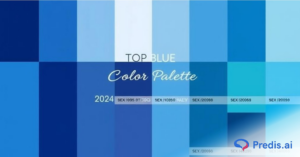Today, social media is a major channel businesses leverage to drive sales and profitability. According to 2023 statistics, 77% of businesses use social media to reach their customers. Additionally, 41% of small businesses depend on social media as a major revenue driver. This means, the competition is stiff! With more competitors rising, performing social media competitive analysis is a no-brainer!
These percentages are only going to increase in the coming years, as more consumers get onto social media. The estimated number of social media users by 2028 is estimated to be 6 billion users. Thus, investments in growing social media channels are important for business growth.
You must understand what is working for them and how they are doing compared to your content. Eventually, this allows you to assess your social media performance and also provides you with tools to enhance your approach. If you’re wondering how to do a social media competitive analysis, you’re in the right place.
In this blog, we’ll cover all you need to know about social media competitive analysis. We’ll cover everything, right from data collection strategies and procedures to drawing conclusions and presenting your results. Read on!
What Does Social Media Competitive Analysis Refer To?
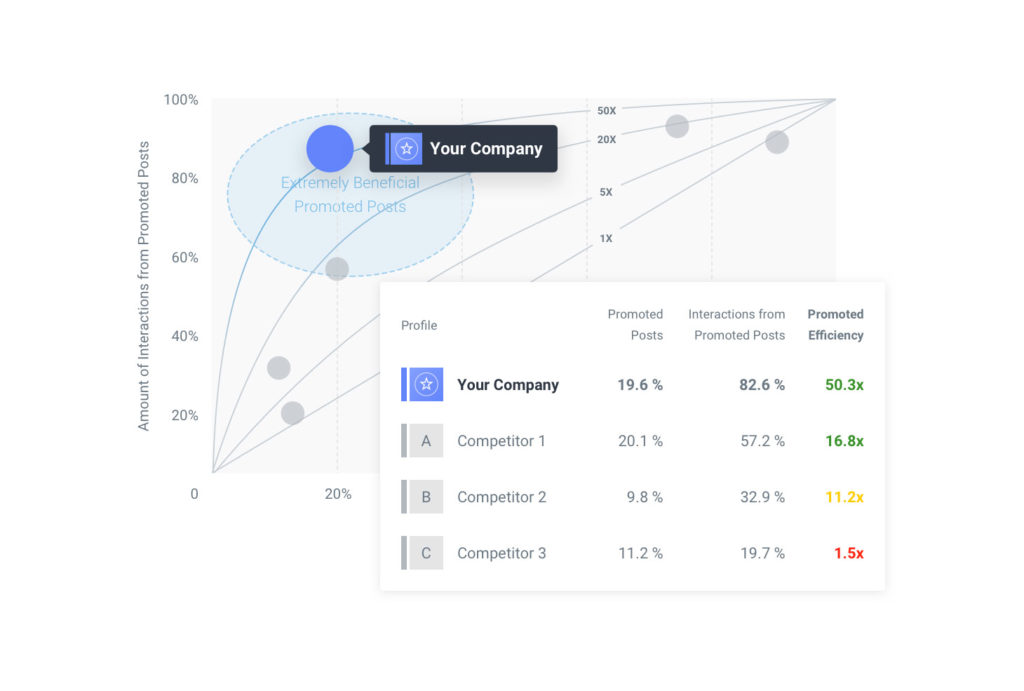
Source: Social Bakers
Operating your social media accounts in a vacuum can be a risky proposition. While investing your resources in driving engagement and conversions through social media is important, it’s also important to know what’s happening with the competition.
Identifying your top rivals and obtaining information about their performance, both (positive and negative) to compare to your own is known as competitive analysis for social media. It is one of the most effective and systematic methods to examine how your online presence compares to the competition. Additionally, it can assist both B2B and B2C businesses.
This form of analysis will force you to look at indicators such as follower count, posting frequency, engagement rate, hashtags, etc. As a result, you’ll learn what works (and what doesn’t), and you’ll find new methods to improve your plan.
You’ll examine important metrics such as follower numbers, engagements, and reach across several platforms, noting their accomplishments and the kind of content that gets the most favorable engagement.
Then, you use this data as a benchmark to compare your performance and identify methods to enhance them.
Six Most Effective Tips To Run a Social Media Competitive Analysis
Social media marketing competitive analysis entails a set of tasks that must be completed on a consistent basis. Therefore, planning is the key to delivering insightful analyses and executing a fantastic job. This, in turn, helps establish and finish successful projects.
You should know precisely what duties you need to perform at each stage and how to complete them with perfection and that is what we will explain in detail in the upcoming sections.
1. Figure Out Your Brand Goals and Metrics
The first step to conducting a social media competitive analysis is to figure out the goals and metrics of your brand. Now, start by deciding what you want for your brand before you look into what your competitors are up to.
Here are some questions that will help you determine what is it that you want for your brand:
- What are the goals that you want to achieve through marketing your brand on social media?
- How will these goals fit with what you have already planned for your overall brand goals?
- Which key performance indicators (KPIs) will you prefer to use to measure the success of your brand against your competitors?
- Who are the ideal clients that you are planning to reach through your social media marketing strategy?
Once you get answers to these questions, you will be able to set clear goals and metrics for your brand.
2. Conduct a SWOT Analysis
A SWOT analysis is a great tool for evaluating your business’s strengths, weaknesses, opportunities, and threats. It helps you gain a clearer perspective on how your brand stands in the competitive social media landscape.
Start by identifying your strengths where you meet or exceed industry benchmarks. These could include
- high engagement rates
- a loyal audience
- unique content
Next, analyze your weaknesses. This might involve:
- inconsistent posting schedules
- lower engagement on certain platforms
- lack of diverse content
Opportunities in your SWOT analysis could be:
- trends you haven’t capitalized on yet
- untapped audience segments
Look for areas where competitors are underperforming and find ways to fill the gaps. Lastly, assess the threats. These could include:
- stronger competitors
- industry changes
- new platforms emerging that you haven’t explored
Use tools to streamline the SWOT analysis process. With its advanced analytics, you can easily gather data and insights to build a comprehensive SWOT analysis. Once completed, use these deeper insights to adjust your social media strategy and stay ahead of the competition.
3. Identify Your Competitors
After you set your brand goals, you need to determine who your major competitors in the industry are. Concentrate on the brands whose services or products are most closely related to yours. Well, you might already know who they are.
To begin, you should target three to five rivals. Investigate each of their social media profiles; you’ll most likely want to target the firms with the most followers and activity.
On the contrary, if you don’t know who your biggest competitors are, Google them! Look for terms that are linked to your solution.
For example, if you own a sporting goods firm, put “sporting goods company” or “sports goods producers” into Google. The results that appear are prospective rivals for your analysis. It’s that simple!
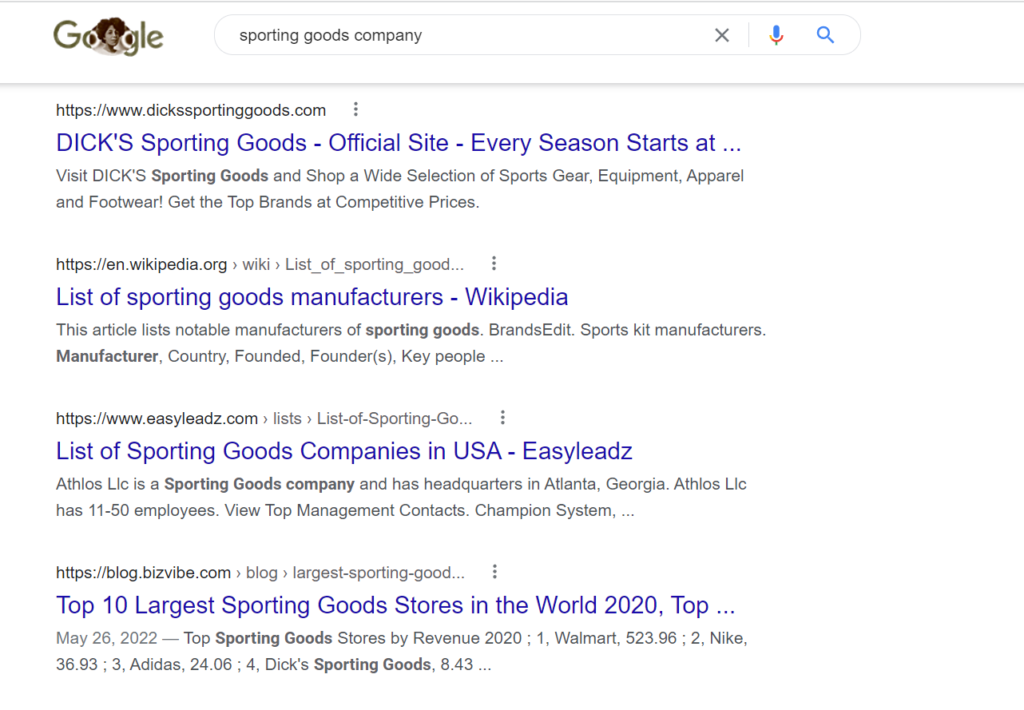
Now, you can select brands from this search to conduct your analysis and study the results. But isn’t this a competitive analysis for social media? Yes, it is! Thus you need to be sure that your search results also rank as top results on targeted social media platforms.
So the brand ranking through your keyword search on Google may not rank well on social media networks.
All you need to do is go to the search bar of the platform for which you want results. Afterward, enter the term in the search bar and check out all the accounts and hashtags that show up there. Finally, select those you feel are your potential competitors that you would like to analyze.
Now that you have a list of your key competitors, let’s begin to collect the data you will need for competitive analysis. To keep costs low during large-scale data collection, especially for startups or small businesses, using cheap proxies can be a practical solution to maintain access and anonymity without overspending. During this process, using the best residential proxy services can help you bypass geo-restrictions and access accurate competitor data from different locations, providing deeper insights into their strategies.
For example, say you searched for a sports goods company on Google and got your results. Now you also need to go to the social media platform for which you want the competitive analysis results. Type your term in the search bar and select the brand you want to analyze.
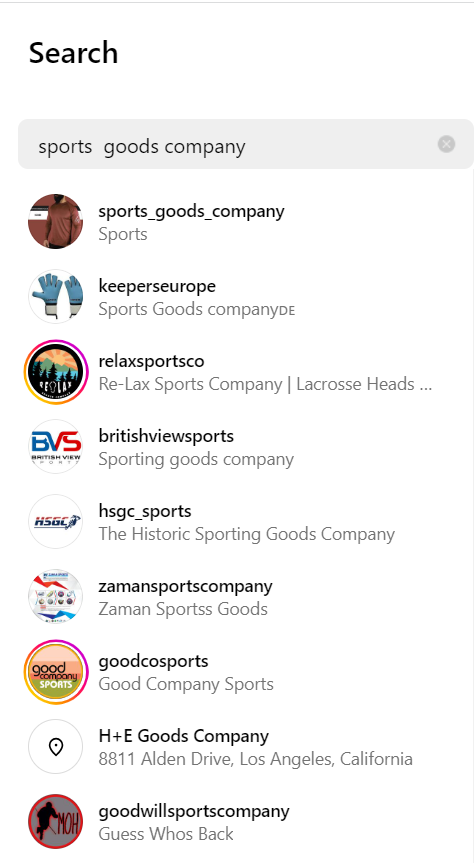
4. Start Collecting Social Media Data of Your Competitors
The next step is to gather social media data. You may adopt one of two methods.
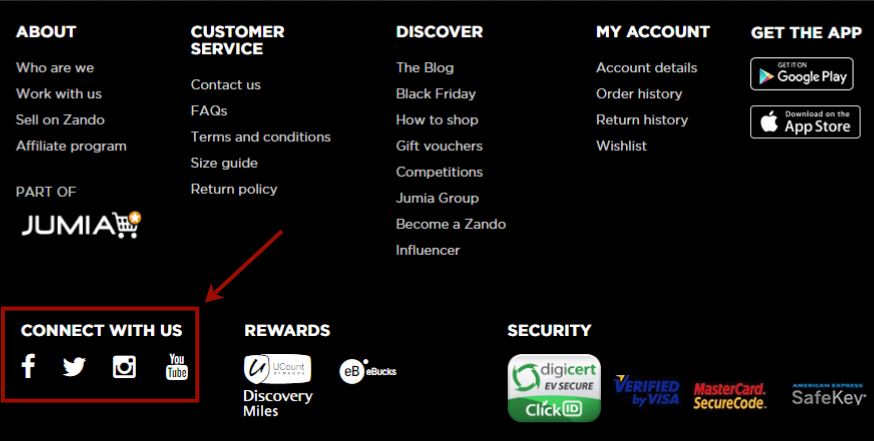
Source: Influencer Marketing Hub
To begin, you can manually gather social media data. Visit your selected businesses’ social media pages and take note of their follower, likes per post, interactions, shares, and more.
Many social media networks, such as Facebook Insights and Twitter Analytics, include native analytics tools. These tools assist you in scraping data about your competition.
To enhance this process and bypass potential access limitations, using a reliable web scraping proxy can help maintain anonymity and prevent IP bans during data collection.
However, it’s a time-consuming and inefficient method. Here, you must visit each social media outlet individually and input all of the data into a spreadsheet.
Because follower numbers and likes fluctuate all the time, the data will never be totally up to date. Furthermore, drawing comparisons across multiple channels and calculating sophisticated metrics is substantially more difficult.
A third issue is that this is a manual data-entry approach, which can be time-consuming and consume financial resources. It can also result in errors and omissions. It is highly unsustainable in the age of 24/7 social media cycles. This is a major problem because social media competitive analysis is a process that must be consistently performed throughout the year.
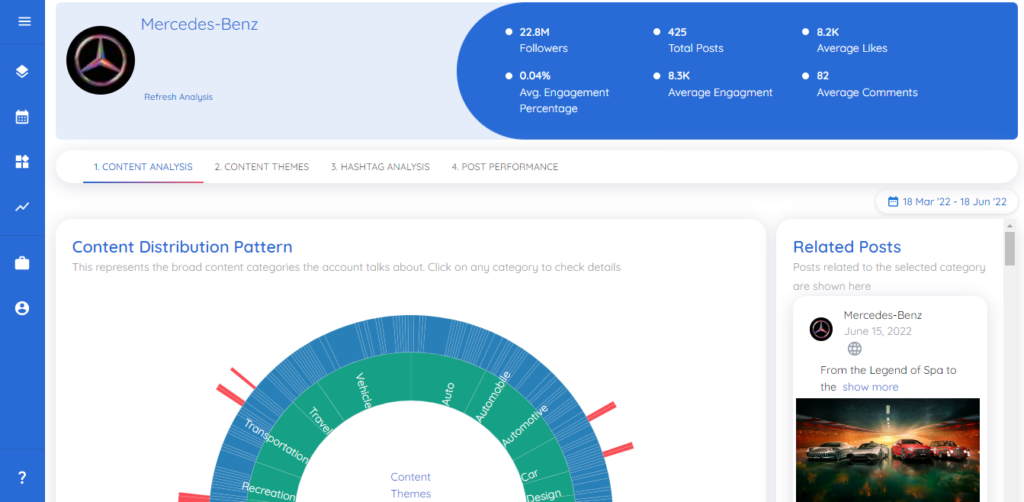
The second alternative is to automate the acquisition of social media data. Tools like Predis.ai gather public data from your competitor’s social media accounts and aggregate it all in one place.
In this manner, you can get precise, full, and timely data from your social media competition study. Consequently, this allows you to derive relevant comparison insights.
All you need to do is add the business profiles you wish to monitor. Predis.ai’s competitive analysis dashboards provide accurate, up-to-date information in a single location.
Create Facebook posts that capture attention and drive engagement with Predis.ai's Facebook Post Maker. Automate Facebook posts and Caption Generation with the help of AI!
5. Analyze the Social Media Data That You’ve Collected
After you’ve gathered your data, it’s time to begin evaluating it. Analysis can be seen as a wide word with several applications. To provide clarity, we prefer to conceive it as an analysis which is a series of questions that provide insights.
Check Which Brand Has Remained Consistent Over Time
On social media, consistency is essential. It’s all part of the process of building a successful brand. When evaluating your competitors, consider how consistent they have been in providing the content.
Depending on the indicators you look at, you should know if a brand has been consistent or dropped the ball somewhere.
Where are Your Competitors Underperforming?
Can you identify any areas where your rivals seem to be failing to produce results?
This may need a bit more work to be determined. Once you’ve defined what ‘underperformance’ looks like, you’ll be able to immediately understand where rivals are failing.
For example, look at engagement values vs. the number of articles published. This is a simple approach to determining whether the competition is failing.
Here are some questions to consider:
- Will you be able to identify the number of likes, shares, and reactions that they receive on average?
- How does one brand compare to all others?
- Which brand gets the lowest engagement?
- What is the size of your competitor’s audience on the social media platform for which you want the results?
- Is the engagement ratio with regard to the audience size high or low?
- How will you determine what the low or high engagement values are for your specific brand or industry?
Which Types of Content are Good Performers and Why?
Identifying top-performing social media material is going to be one of the most important components of your investigation. When doing so, don’t stop at determining if blog articles or videos are effective; instead, go further.
Pay close attention to your competitors’ videos. Examine them.
Here are some questions to consider:
- Was the video structured and what is it that the structure includes?
- How long is each video on average?
- Who appears in their videos?
- What kinds of information do they share?
- Do they make any offers?
- How strong are their calls to action?
How Often Are Your Competitors Publishing Content?
Understanding the regularity with which your rival releases content is also important. Frequency is important since all companies must sell themselves to remain relevant, yet they all have financial limits.
Yes, some businesses have higher resources, but that doesn’t guarantee they know how to efficiently employ them.
When you study your competitor’s frequency of social posting, you may categorize the sorts of posts they produce by format. This will allow you to observe the content kind people are concentrating on.
You’ll be able to establish a strategy for your content creation based on the sorts of content proven to achieve results. But first, you need to recognize the types of content the brands are creating. This step is also key for presenting the competitive landscape and the results of your analysis effectively to stakeholders or your internal team.
6. Take Action
Finally, after you’ve met your marketing team, act on your findings and start making adjustments to your social media plan. Try out some fresh hashtags that your rival has used and that you haven’t used previously.
Alternatively, consider providing more evergreen content since such sort of pieces generate high interaction rates from your competitors. You should include freshly found keywords in your account biographies to make your brand apparent to consumers who actively search.
Whatever path you choose, the key line is to put what you’ve learned into practice and don’t be hesitant to experiment. That is, after all, why did you do a competitive social media analysis in the first place?

Four Competitive Analysis Tools for Social Media
Want a peek at what’s going on with your neighboring company? Would you like to track, analyze, and learn from your competitors’ strategies?
Here are four social media competitive analysis tools that will help you gather information to boost your marketing campaign:
1. Predis
Let’s take a look at Predis’s competitive analysis tool. The tool allows you to dig deep into your competitors’ content patterns, showing the best and worst-performing content. Moreover, you can easily take a look at the hashtag set used by your competitors.
This enables you to understand what type of content works best for your competitors. Additionally, you get a look at the hashtag set that drives their post engagement.
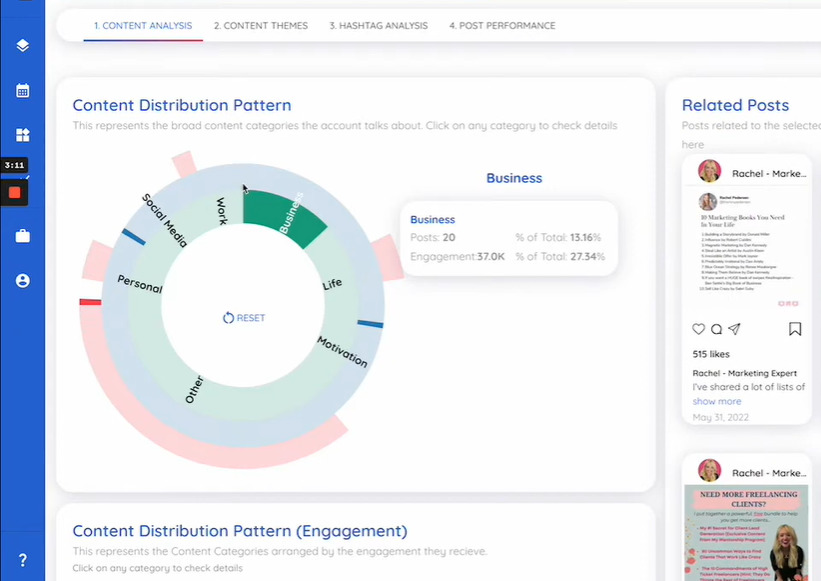
Now all you need to do is leverage this information for validating your future campaign ideas. Otherwise, just use this information to get inspired for your next post ideas.
Additionally, the analysis tool provides you with deep insight into industry trends and competitor behavior. So now you can buckle up to woo your clients by presenting them with deep analytic reports regarding market strategies.
Steps to Perform Competitive Analysis with Predis AI
To perform analysis with the Predis AI competitive analyzer tool, do the following:
- Use this tool and log in with your email ID.
- Once you are on the home screen, select the “Competitor analysis” option on the left-hand side of the screen.
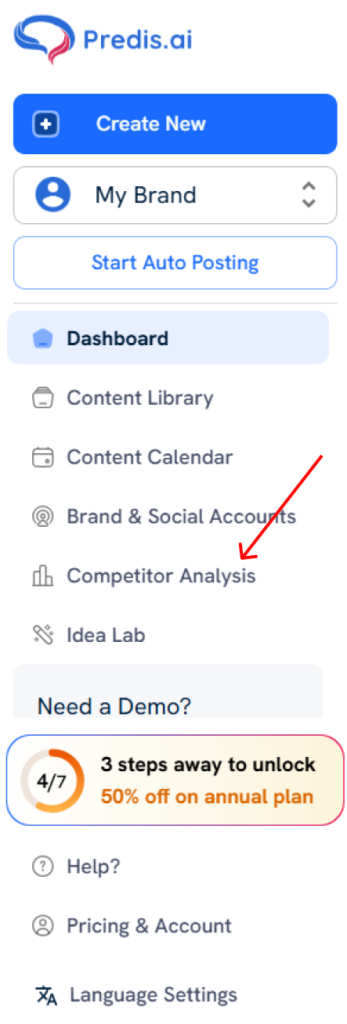
- Input the Instagram and Facebook accounts of your competitors and start analyzing.
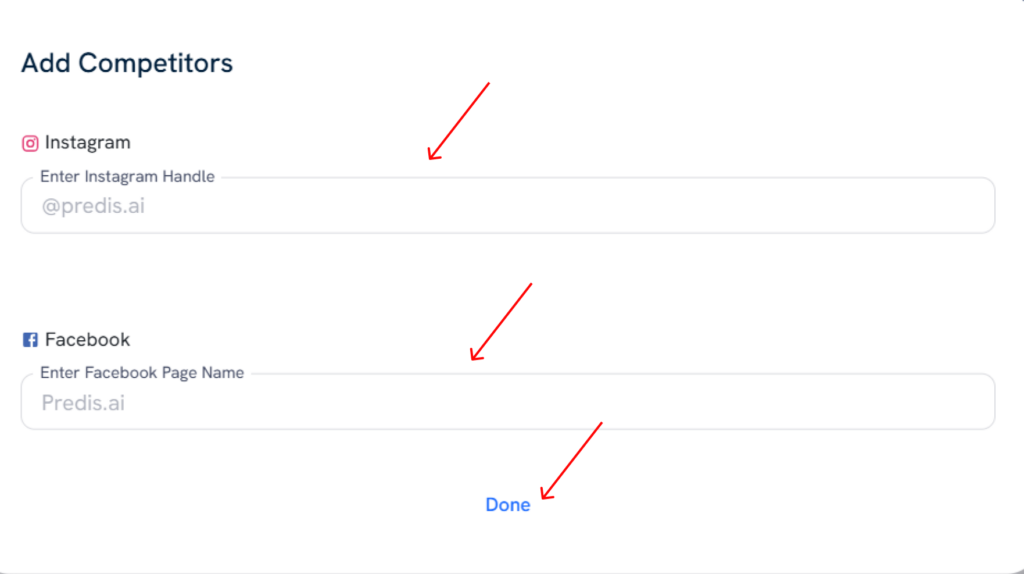
- Select the time duration for which you want to analyze and then you are good to go. Check out your analysis to find more details about your competitor’s content strategy.
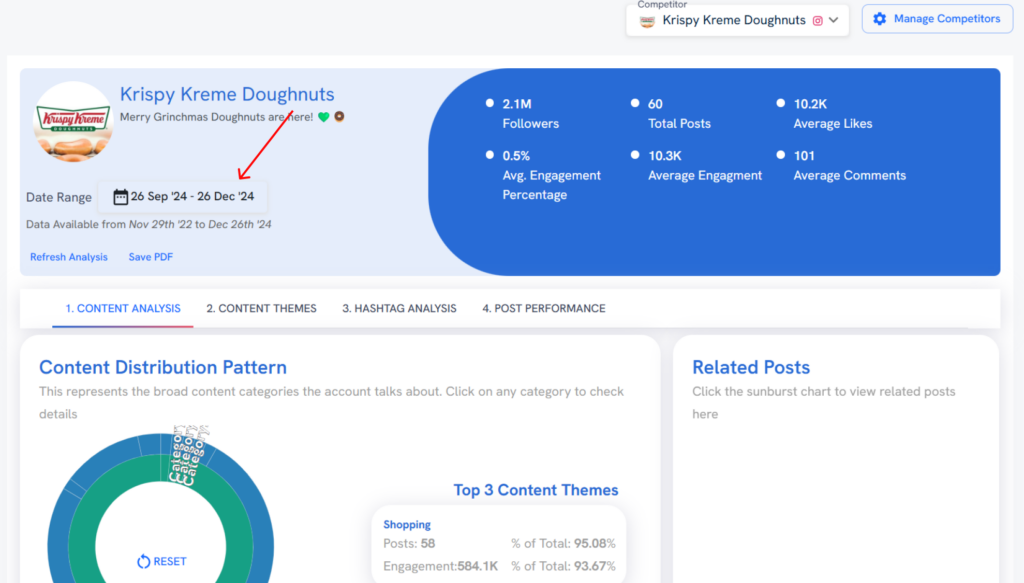
2. BuzzSumo
Ready to track the key performance indicators around your competitors’ marketing activities? Then BuzzSumo is where you need to land. With the BuzzSumo competitive analysis tool, you get your answers to:
- What content works best?
- Which are the best-performing networks?
- Which audience is sharing their content?
- How does your content compare to theirs?
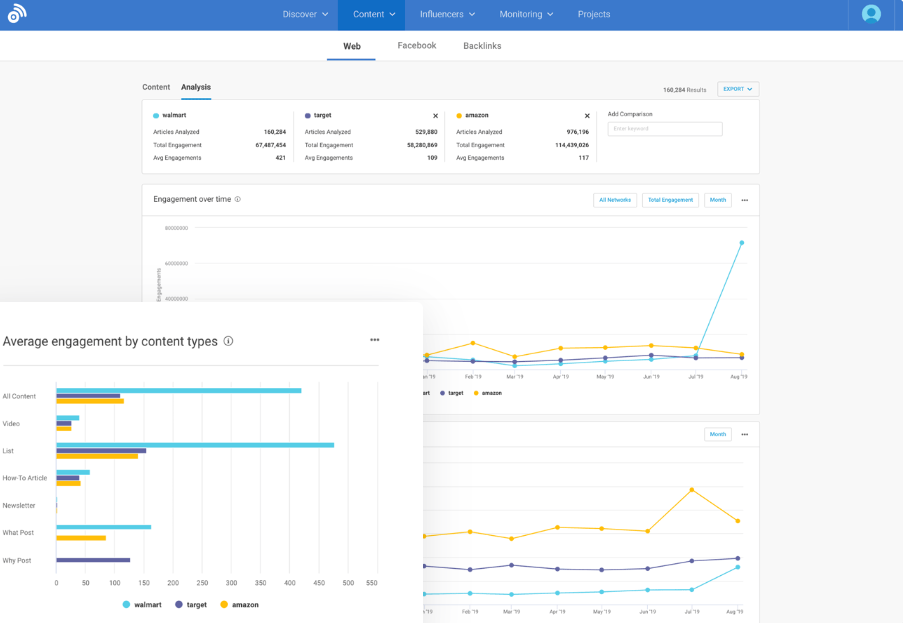
Source: BuzzSumo
Now you can sit tight and take a look at top-performing content for relevant topics of specific competitors. It not only looks at the engagements but also where the content has been shared across the web.
This helps you to know whose content is running at the top of the industry. Moreover, you get to explore on your own the latest potential hot topics.
3. Ahrefs
The competitive analysis tool from Ahrefs allows you to study the key aspects of your competitor’s website such as:
Organic traffic performance
You can check what keywords are used by your competitors and how much traffic those keywords bring to their websites. Ahrefs monitors millions of keywords across various locations. This allows you to estimate a website’s organic search traffic on Google.
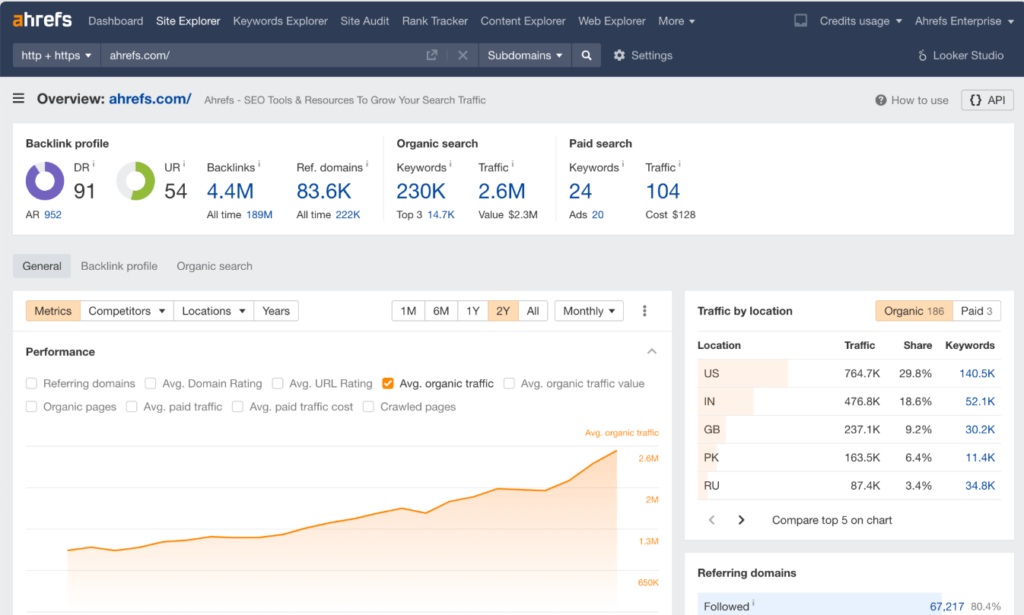
Source: Ahrefs
Backlink profile
As it has the fastest backlink crawler in the industry, you can track the backlinks used by your competitors’ websites. You can also analyze the quality of the backlinks used by them.
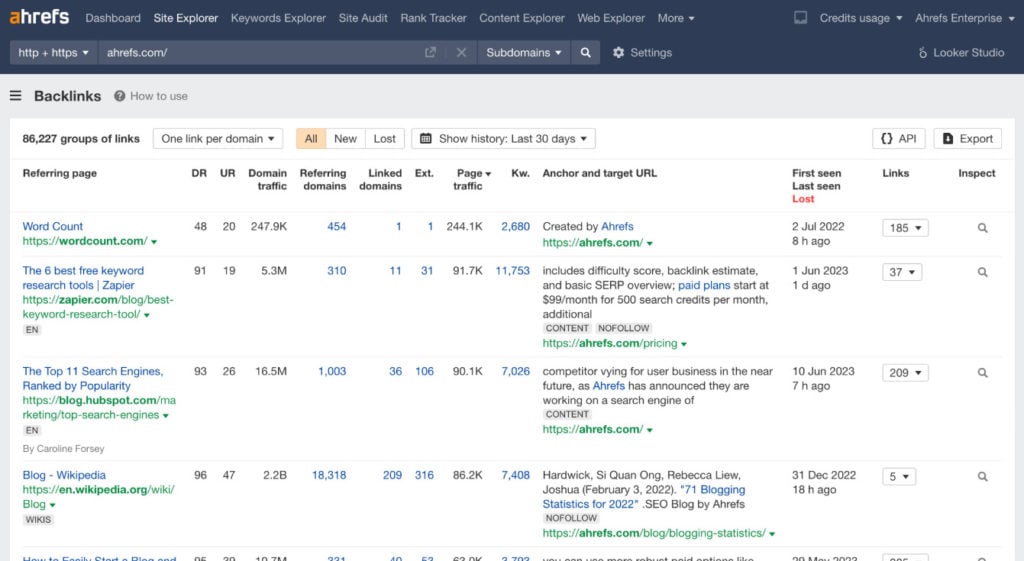
Source: Ahrefs
Paid traffic performance
This allows you to check whether your competitor is into paid search advertising. Moreover, you can even track where they funnel their paid traffic to.
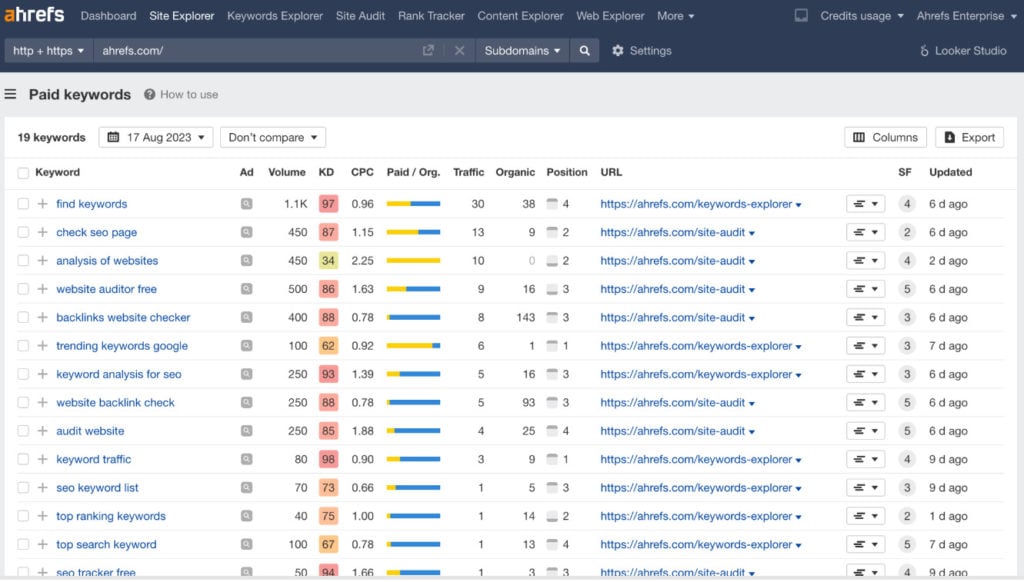
Source: Ahrefs
Additionally, Ahrefs provides you with historical data of 7+ years. This makes it possible for you to track previous keywords, backlinks, and traffic history of your competitor. Now you can use this through research to improve the performance of your company.
4. Alexa
Alexa is a competitive intelligence software that provides you with keyword research, competitive websites, target audience analysis, and SEO analysis.
Here, you are provided with a great opportunity to discover the target audience of your competitors in the industry. The competitive analysis of this tool helps you identify the demographic data of customer persona, content strategy, PID traffic targeting, etc.
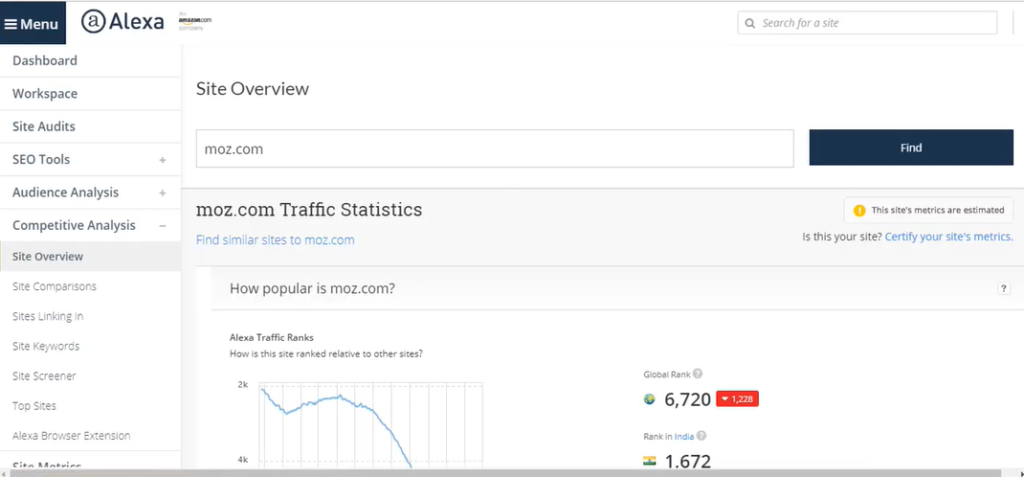
Moreover, you get to discover new competitors in the industry. This allows you to compare your website’s traffic and engagement with those of your competitors. You can also easily determine the visibility of your brand’s website against that of your competitors.
So with the help of these above-given competitive analysis tools, select the one that suits you the best. These tools are very useful for you to keep track of the progress made by your competitors in the industry.
Examples of Social Media Competitive Analysis
You could be asking what indicators to evaluate in a social media competitive study and what conclusions to draw from your results.
The metrics you monitor are usually determined by your social media KPIs. Here are some indicators for measuring social media success across several platforms.
1. Instagram Social Media Competitive Analysis
Instagram, being an image-based medium, is popular among beauty firms. It’s a terrific platform for them to advertise their goods and repost user-generated material. It also includes selfies from beauty bloggers and makeup artists.
Key takeaways from the following analysis:
- With Predis AI, we are now analyzing Instagram’s competitor profile and you can see the key metrics displayed in the banner.
- With AI, the tool has classified the competitor content, from which you can find out the type of content that works best.
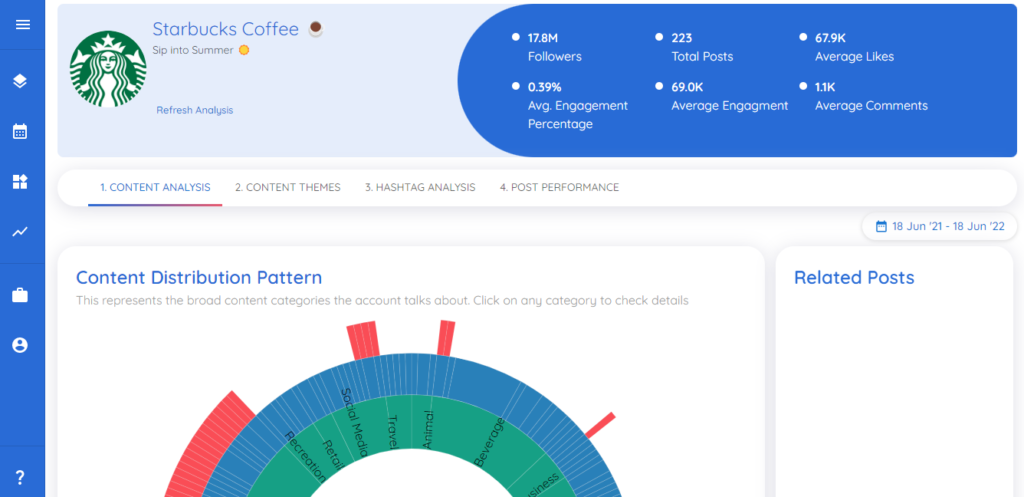
- The sunburst chart shows their content distribution and engagement rate across posts which can be used for your advantage.
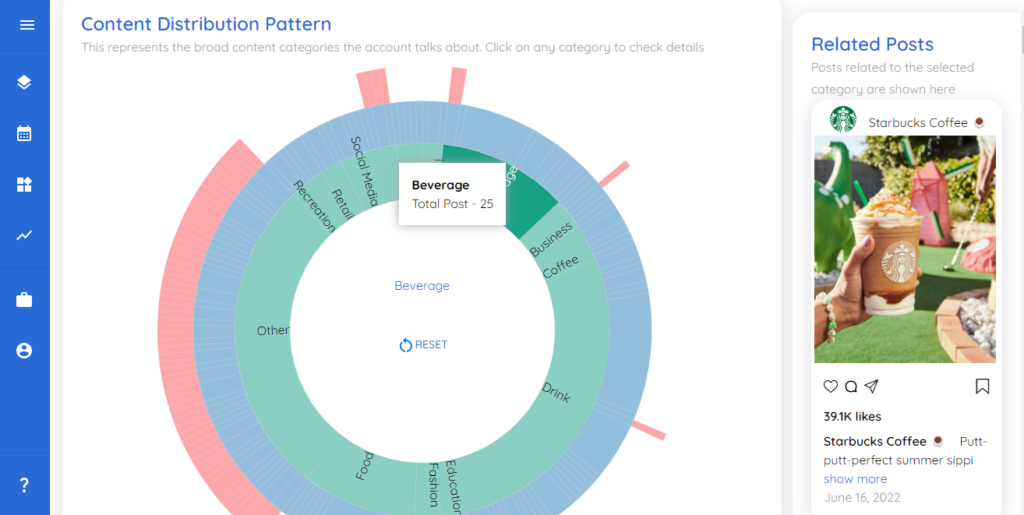
source: Predis.ai
2. Facebook Social Media Competitive Analysis
If Facebook is your primary channel, you should examine how you compare to their competition on the network.
For this analysis, we have chosen Mercedes-Benz and Chanel. On Predis.ai, we see that they have a good amount of followers and posts but their average engagement rate is low.

It can be observed that they have a good amount of content around the Luxury category, as they are a luxury brand. The categories that pop up are all around their business, like design, automobiles, transport, motor, and so on.
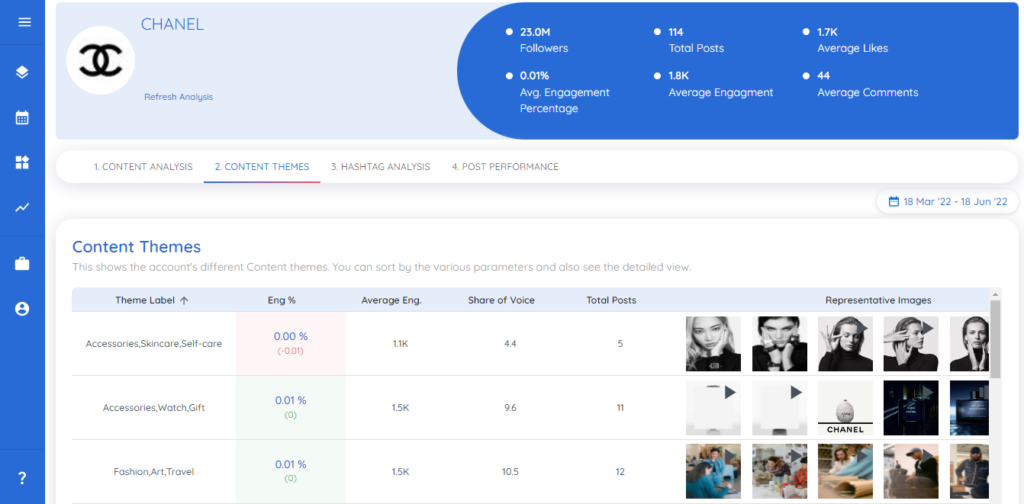
source: Predis.ai
You can see the posts categorized with their AI. Meaningful insights can be derived from this social media competitive analysis example such as the average engagement rate, the share of voice, and the engagement percentage. You can observe that they have a better share of voice in the Fashion, Art, and Travel categories.
3. X (Twitter) Social Media Competitive Analysis
Let’s have a look at Twitter now. We picked three prominent fast-food restaurants for this example: Wendy’s, Taco Bell, and Chipotle.
Wendy’s has approx 3.7 million followers, followers, much more than competitors Taco Bell or Chipotle. The second graph, on the other hand, shows an unusual surge in Chipotle’s followers over three days.
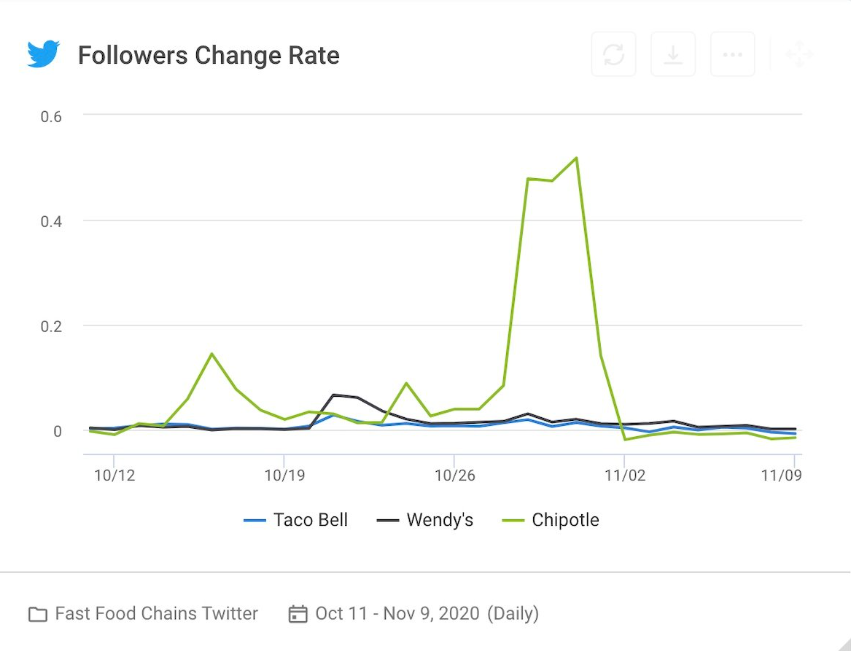
Source: Quintly
Based on this information, you should investigate what Chipotle was blogging about over those three days. This will help you to determine whether a similar strategy may work for you. Perhaps one of its postings has gone viral! So let’s go a little further.
The table below displays the most retweeted tweets from Chipotle throughout those three days. Of course, there will be a Halloween contest! Perhaps that’s a strategy you should keep in mind for your client’s next Halloween promotion.
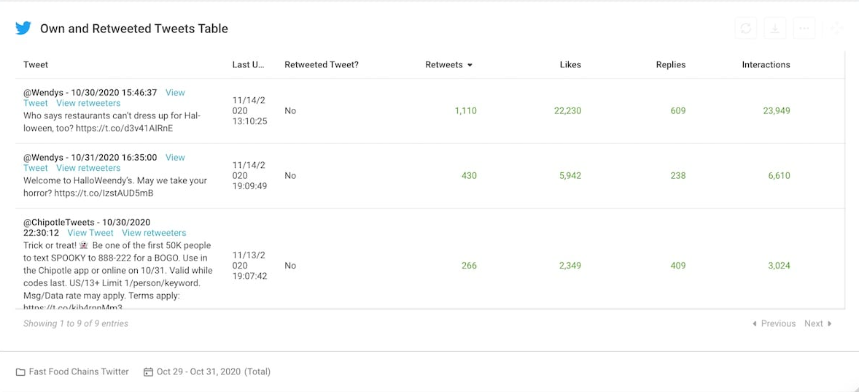
Source: Quintly
Why to do a Social Media Competitive Analysis
1. Gain Insight into Industry Trends
Staying on top of industry trends is key to being relevant and competitive on social media. Analyze your competitors to see what content formats, hashtags and platforms are trending.
By tracking these trends regularly you can adjust your content strategy to what’s working. Use tools like predis.ai to track trends across multiple platforms and keep your strategy fresh.
2. Reach New Audiences
One of the biggest benefits of competitive analysis is finding new audience segments. By analyzing your competitors’ audience engagement you can find demographic groups you’re not reaching yet. This gives you a roadmap to expand your reach.
For example, if your competitors are getting traction with a younger demographic you haven’t targeted before. You can adjust your content and messaging to appeal to that audience. Use competitive analysis insights to refine your targeting and create content that resonates with new groups.
3. Identifying Opportunities for Improvement
Competitive analysis helps you find areas where your competitors are beating you. It gives you the chance to adjust your strategy and improve your social media metrics. By analyzing their content and engagement strategy you can see where they’re doing well and find opportunities to improve yours.
Tools like Predis.ai allow you to track and improve your performance by monitoring your competitors. Use this data to plug the gaps in your strategy and stay competitive. With the right adjustments, you can boost your social media performance and keep up with or even beat the competition.
4. Staying Ahead of the Competition
To stay ahead you need to monitor your competitors consistently. Use social media monitoring tools to track conversations around your brand and your competitors. This will give you an idea of how your brand is perceived compared to others in your industry.
Best Practices for Competitive Analysis
A structured approach to competitive analysis ensures you don’t miss key insights. Use a competition analysis for social media template to compare your brand’s performance with competitors. This helps you visualize your strengths and areas for improvement.
Regularly use social media analytics tools to gather data on competitor performance. Look for trends, high-performing content types, and engagement metrics. Identify where competitors are excelling and make adjustments to your strategy to stay competitive. The data you gather will guide decisions that give your brand a competitive edge.
Monitoring Progress and Adjusting Your Social Media Strategy
- Continually monitoring social media performance, along with other digital marketing services like SEO, content marketing, and paid ads, is essential for consistent growth. This is a common approach followed by many digital marketing companies, including Oxygen. Run regular social media bench-marking analyses to see how your brand compares. This allows you to identify areas for improvement and adjust your strategy accordingly.
- Stay on top of your community management by responding to comments, questions, and feedback.
- Monitor your engagement rate to ensure your content resonates with your audience.
- Use social media analytics tools to gather data on your competitors’ posts, follower growth, and engagement metrics. This keeps you informed and helps guide your strategy adjustments.

Wrapping It Up
Analyzing your direct competitors’ moves is a critical component of any marketing plan. So now you know that the use of social media is widely spread across the world. Thus, knowing the complexity of how your competitors use their social media platforms may offer you a significant competitive edge. Again, this should be a goal for every organization.
If you’re looking to turbocharge the social media performance of your brand, consider partnering with Predis.ai‘s competitive analysis tool to get access to quality data on a timely basis, and activate a strategy.
You can also leverage Predis-ai’s superior AI-powered content generation capabilities and data-driven analytical approach to automate the generation of high-quality content that drives engagement, conversations, and conversions.
For more such informative posts about social media tips and tricks, stay connected to Predis AI.
Level up your Instagram game with our free hashtag generator tool!
For more social media tips and updates, follow us on our Instagram!
You May Like,
How do you use AI in social media marketing?
Social Media Content Pillars and How Can you make yours?
How to get on top of your game as a social media content creator?
FAQs
A social media competitive analysis is the process of evaluating your competitors’ social media performance to understand their strengths, weaknesses, and strategies. It involves gathering data on their content, engagement rates, follower growth, and overall performance to compare it with your own.
The social media industry is highly competitive, with millions of businesses vying for attention on platforms like Instagram, Facebook, Twitter, and LinkedIn. Staying ahead requires a consistent, well-planned strategy that leverages data, trends, and engagement insights.
A social media competitor strategy is an approach where businesses analyze their competitor’s social media activity to inform their own tactics. This can include studying content types, posting frequency, engagement strategies, and audience interaction to understand what works and where improvements can be made.
To analyze a social media strategy, review metrics such as engagement rates, follower growth, reach, and content performance. Compare these metrics against industry benchmarks or competitor data. Tools like predis.ai can help streamline this process by gathering and analyzing data across platforms.








